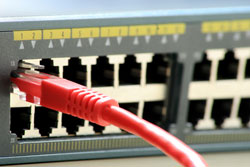Domain names for accessing internet resources
6NET was a European Information Society Technologies (IST) programme aiming to demonstrate that continued growth of the Internet can be met by exploiting new Internet Protocol version 6 (IPv6) technology. More than 30 project partners from the commercial, research and academic sectors combined their experience and resources to build and operate a pan-European native IPv6 network connecting 16 countries. This network was extensively used to test a variety of new IPv6 services and importantly, interoperability with legacy applications. It allowed practical operational experience to be gained, and provided the means to evaluate migration strategies, which are important considering that IPv4 and IPv6 will coexist for several years. IPv6 was intended to be used as the transport protocol as widely as possible during the life-cycle of the 6NET project. This required alignment and integration of the Domain Name System (DNS) service of the 6NET with the existing IPv4-based Internet. DNS is a complex set of functions and services which can provide a reliable translation from names to addresses (IPv4 and IPv6) and from addresses to names. More specifically, the forward DNS service provides name-based identification and access to the various components available on the Internet, by supplying an IP address. On the other hand the reverse DNS service provides the translation of numeric IP addresses back to meaningful names, as well as for some security facilities. Within the 6NET network DNS services were operated on top of the IPv4 protocol stack. Totd, a small DNS proxy name server running on a single host proved useful for laptop and other portable devices that roam between IPv6-only, dual stack and IPv4-only networks. This facilitates applications with an IPv4-only resolver to make DNS queries via the proxy, when IPv6-only DNS servers are available. However, transition mechanisms deployed somewhere on the 6NET network could be tested when a totd DNS proxy was shared by multiple sites. Documentation, as well as the source code of the DNS proxy software is freely available for a variety of operating systems on the Internet.







